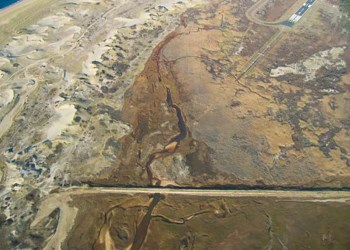
NPS Image In contrast with the small number of plant species, the diversity of marine and estuarine animals that find food and shelter here is very high. Marine fish, shellfish, crabs and lobsters rely on salt marsh habitats at critical life stages.
Until 1930, the wetland northeast of the dike was part of this productive salt marsh. The installation of the dike caused dramatic changes in plant and animal communities. The blockage of saltwater and the addition of freshwater from rainfall and groundwater inflow allowed freshwater-adapted plants to move in and crowd out those adapted to saltwater. Invasive plants, such as the common reed (Phragmites australis) thrived. Also, the lowered water level and lack of tides made it impossible for estuarine fish to reach and feed on the wetland surface. One result was that important predators to mosquito larvae, especially killifish, could not reach mosquito breeding sites in high marsh pools.
In 1987, following extensive research, the National Park Service (NPS) initiated a program to restore the marsh. The first step was to remove a tide gate that had prevented seawater from passing through a small culvert between the two wetlands. Saltwater flow was restored, and fish gained access to the marsh. In 1999 four 7' X 3' box culverts replaced the small culvert. These culverts have been opened incrementally since then, causing tide heights and salinities to again approach those of the natural marsh area. NPS scientists monitoring the project are noticing significant changes. The invasive common reed is dying. Shellfish have re-colonized the area and estuarine fish are again foraging in tidal creeks and on the marsh surface. With each new high tide this marsh is being revitalized. We invite you to return again to witness this dynamic process.
|
Last updated: April 28, 2015
